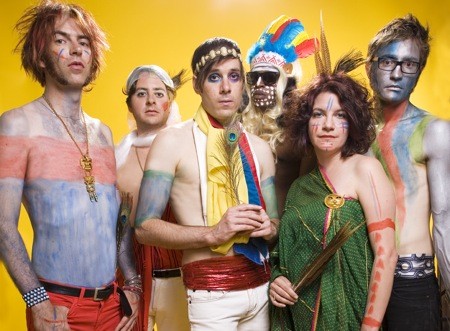Although they live and work in Brooklyn, Mark Heyner and Josh Kolenik had to get out of the city to record as Small Black. Last year, the duo holed up at Kolenik’s uncle’s house on Long Island, recording a handful of fuzzed-around-the-edges pop songs away from the diversions of the city. More recently, the band, by now a quartet instead of a duo, trekked to the shores of southern Delaware, set up a makeshift studio in a beach-front house, and began recording songs for their full-length debut, tentatively planned for release this fall.
“Brooklyn’s good for us to get things started,” Kolenik says, “but to really think about stuff critically, we can’t have that many distractions. We need a place to get away and have quiet and space to work.”
Small Black’s music reflects both the busy borough and the serene sojourn: The lo-fi songs on their debut EP combine delicate melodies with the subdued clatter of rickety synths and scavenged drum machines, like early-’80s new wave playing on a busted-up radio. They sound at once pastoral and urban, inviting and disarming, dreamy but damaged.
That sound places them squarely in a group of bands that are being lumped together, rightly or not, as “glo-fi” or “chillwave” — two interchangeable labels generated on blogs and arousing the same skepticism as electroclash or hipster metal. So far, it’s less a new musical genre than a permutation of a scene, one defined not by geography, proximity, and the free exchange of ideas but by synchronicity, serendipity, and technology. According to Kolenik, it’s a scene that “exists on the Internet. It’s not in a city, and it’s not connected to any reality, which is weird. Everybody’s pretty far apart. It’s not like we’re playing shows together and bouncing ideas off each other. It’s happening through modems.”
In fact, aside from a small Brooklyn contingent, most of these bands are geographically disparate and initially worked in a bubble: Washed Out hails from Georgia; Picture Plane from Denver; Delorean from Barcelona. Sequestered on Long Island, Small Black recorded with little knowledge that anyone anywhere was doing anything similar with these influences and instruments. “In our first review, we got compared to all these bands, and I had not heard of a single one of them,” Kolenik says. “So we checked them out, and I thought, these bands are really good. I’m fine with this.”
With vocals and instrumental parts that sound live instead of sampled, Small Black come across less like a DJ than a live band, making the most of their limited recording conditions. With its tripping drum-machine beat and gauzy production, “Pleasant Experience” sounds like the soundtrack for John Hughes’ lost mumblecore film, while “Bad Lover” turns its relentless mechanical rhythms and glaring synths into bubblegum industrial. The stand-out track, not just on the EP but in this loose scene, is “Despicable Dogs,” whose opening bass thumps warily form a heartbreak beat for Kolenik’s dreamy chorus.
The EP garnered kudos from Pitchfork, Stereogum, and other Internet outlets — a response the musicians never expected from their self-recorded, self-produced, and self-released debut. In fact, Kolenik and Heyner had formed a small label, CassClub Records, and had taught themselves the ins and outs of manufacturing, publicity, and distribution — all on a very local level. Kolenik says the experience was invaluable: “It was fun to figure it all out. It felt good to do it and not wait around for someone else’s help. We could do it again if we needed.”
They probably won’t need to resort to that, however. Following the success of their EP, Small Black signed with Jagjaguwar, an imprint of the venerable indie label Secretly Canadian and home to such diverse acts as Okkervil River, Bon Iver, and Dinosaur Jr. “In general, they put out great records, and their bands have long careers,” Kolenik says. “They’re not flash-in-the-pan artists, and that’s the kind of label we wanted to be associated with.”
Rather than rush ahead with a proper full-length, Small Black are re-releasing their EP through Jagjaguwar with two new tracks: the relatively upbeat B-side “King of Animals” and the windblown suite “Baby Bird Pt. 2.”
“We really wanted to get a release out quickly with proper PR and proper distribution,” Kolenik says, “so that people could actually buy it.”
As Small Black launch their first nationwide tour and finish up their full-length, these early songs are changing subtly but crucially from the studio to the stage, especially with the addition of longtime friends Juan Pieczanski and Jeff Curtin, who form a tight rhythm section.
“We knew we didn’t want to be a laptop band if we could get away with it, because it’s more interesting to watch a band play a song and get through the parts,” Kolenik says. “Every night we play something, we find a new wrinkle, a new detail, a new sample that fits. We’re definitely itching to play some new stuff, but we’re still very excited about touring on this material.”
And they’re taking all the labels and expectations in stride. “I guess we aspire to be as chill as possible now,” Kolenik says with a laugh.

